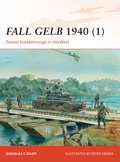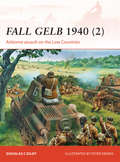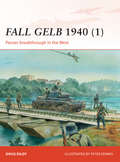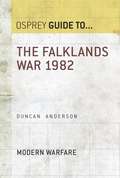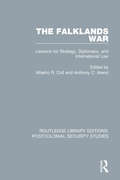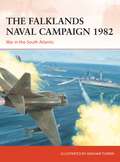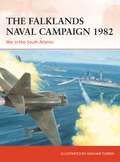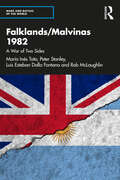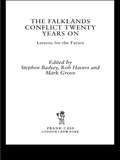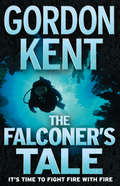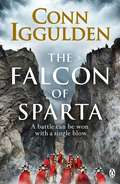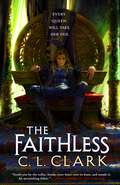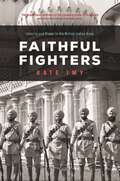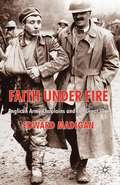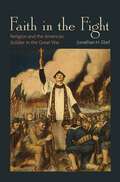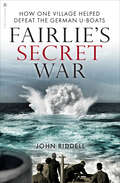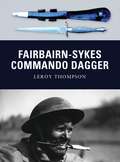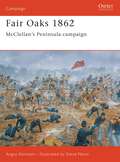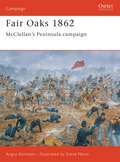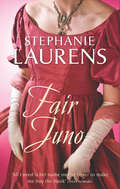- Table View
- List View
Fall Gelb 1940: Panzer breakthrough in the West (Campaign)
by Peter Dennis Doug DildyNever in the history of warfare has the clash between such great and apparently equal forces been decided so swiftly and conclusively as the German conquest of France and the Low Countries in May and June of 1940. Not deigning to spend itself against the extensive fortifications of France's Maginot Lines, Hitler's Wehrmacht planned to advance its 136 (of 157) divisions through Belgium and northern France in order to destroy the Allied forces there and gain territory from which to prosecute continued combat operations against France and England. Beginning on 10 May 1940, this title follows the fortunes of Heeresgruppe A as its three Panzer Korps moved stealthily through the dark, hilly, and thickly forested Ardennes in southern Belgium before forcing a passage across the river Meuse and racing through France to the Channel in one of the most daring campaigns in history.
Fall Gelb 1940: Airborne assault on the Low Countries (Campaign #265)
by Peter Dennis Doug DildyThe great blitzkrieg campaign of May/June 1940 saw German forces pour through Holland and Belgium to confront the French and British. The assault was audacious; it relied on speed, feinting and manoeuvre as much as superior force, and in the end these qualities were to prove decisive to German success. Featuring vivid illustrations, illuminative bird's eye views and maps, this book charts the unfolding of an unprecedented 'lightning war', which saw the first ever airborne assault at a strategic level, and the largest clash of armour to date. Never in the history of warfare had the clash between such large, powerful, and apparently equal forces been decided so swiftly and conclusively.
Fall Gelb 1940: Panzer breakthrough in the West (Campaign #264)
by Peter Dennis Doug DildyNever in the history of warfare has the clash between such great and apparently equal forces been decided so swiftly and conclusively as the German conquest of France and the Low Countries in May and June of 1940. Not deigning to spend itself against the extensive fortifications of France's Maginot Lines, Hitler's Wehrmacht planned to advance its 136 (of 157) divisions through Belgium and northern France in order to destroy the Allied forces there and gain territory from which to prosecute continued combat operations against France and England. Beginning on 10 May 1940, this title follows the fortunes of Heeresgruppe A as its three Panzer Korps moved stealthily through the dark, hilly, and thickly forested Ardennes in southern Belgium before forcing a passage across the river Meuse and racing through France to the Channel in one of the most daring campaigns in history.
The Falklands War 1982 (Guide to...)
by Duncan AndersonThe Argentine invasion of the Falklands in 1982 sparked national outrage and Britain felt she had to avenge the humiliation and protect her own. This volume explores both the military and political dimensions of this important conflict, including detailed accounts of the air / sea battle, the Battle for San Carlos Water, Goose Green, Mt Harriet, Tumbledown and many others. It explains how success in the Falklands set the stage for the years of Thatcher's dominance, and restored British prestige. Including first hand accounts from both soldiers and civilians, this is an interesting and thoroughly up to date appraisal.
The Falklands War: Lessons for Strategy, Diplomacy, and International Law
by Alberto R. Coll and Anthony C. ArendFirst published in 1985, The Falklands War was the first comprehensive work of its kind. The book brings together a wealth of work by scholars and practitioners in the fields of diplomacy, military affairs, and international politics and law. It provides a comprehensive and objective overview of the Falklands War and the underlying crisis that continued following it. This volume is a detailed study suitable for anyone wishing to expand their knowledge of the Falklands War.
The Falklands War: Lessons for Strategy, Diplomacy, and International Law
by Alberto R. Coll Anthony C. ArendFirst published in 1985, The Falklands War was the first comprehensive work of its kind. The book brings together a wealth of work by scholars and practitioners in the fields of diplomacy, military affairs, and international politics and law. It provides a comprehensive and objective overview of the Falklands War and the underlying crisis that continued following it. This volume is a detailed study suitable for anyone wishing to expand their knowledge of the Falklands War.
The Falklands Naval Campaign 1982: War in the South Atlantic (Campaign)
by Edward HampshireThe Falklands Conflict was remarkable for many reasons: it was a hard fought, bloody and short conflict between a leading NATO power and one of the most capable armed forces in South America; it demonstrated the capabilities of a range of cutting-edge technologies including nuclear-powered attack submarines, Exocet missiles and Sea Harrier VSTOL aircraft; and it was fought many thousands of miles away from the Royal Navy's home bases.In this illustrated study, renowned naval historian Dr Edward Hampshire draws upon the latest available sources to offer a comprehensive examination of the Falklands naval campaign. Blow-by-blow accounts of key engagements, such as the sinking of the General Belgrano, the loss of HMS Sheffield, and the landings at San Carlos Bay, are presented alongside lesser known but equally important naval operations that helped shape the outcome of the conflict.
The Falklands Naval Campaign 1982: War in the South Atlantic (Campaign)
by Edward HampshireThe Falklands Conflict was remarkable for many reasons: it was a hard fought, bloody and short conflict between a leading NATO power and one of the most capable armed forces in South America; it demonstrated the capabilities of a range of cutting-edge technologies including nuclear-powered attack submarines, Exocet missiles and Sea Harrier VSTOL aircraft; and it was fought many thousands of miles away from the Royal Navy's home bases.In this illustrated study, renowned naval historian Dr Edward Hampshire draws upon the latest available sources to offer a comprehensive examination of the Falklands naval campaign. Blow-by-blow accounts of key engagements, such as the sinking of the General Belgrano, the loss of HMS Sheffield, and the landings at San Carlos Bay, are presented alongside lesser known but equally important naval operations that helped shape the outcome of the conflict.
Falklands/Malvinas 1982: A War of Two Sides (Wars and Battles of the World)
by María Inés Tato Peter Stanley Luis Esteban Dalla Fontana Rob MclaughlinAfter four decades from the 1982 war between Britain and Argentina over possession of the Falklands/Malvinas islands in the South Atlantic Ocean, this book allows for a new and rounded reading of the causes, course and consequences of the war. It provides a comprehensive overview of the Falkland/Malvinas War by integrating the military history of the conflict into the diplomatic, political, social and cultural aspects of the war. Including a substantial body of advocacy, chronicle, narrative and analysis, the volume draws upon an extensive range of published sources, in English and Spanish, primary sources from both sides and unpublished testimonies. The book, written by Argentine and Australian historians and scholars, discuss themes such as the background to the war, the offensive campaign for the islands and the English and Argentine experiences and memories of the war from the perspective of the islanders. Being part of the Wars and Battles of the World series, this book will be an essential read for scholars and researchers of military history, British history, Latin American history, defence and strategic studies, geopolitics and modern history.
Falklands/Malvinas 1982: A War of Two Sides (Wars and Battles of the World)
by María Inés Tato Peter Stanley Luis Esteban Dalla Fontana Rob MclaughlinAfter four decades from the 1982 war between Britain and Argentina over possession of the Falklands/Malvinas islands in the South Atlantic Ocean, this book allows for a new and rounded reading of the causes, course and consequences of the war. It provides a comprehensive overview of the Falkland/Malvinas War by integrating the military history of the conflict into the diplomatic, political, social and cultural aspects of the war. Including a substantial body of advocacy, chronicle, narrative and analysis, the volume draws upon an extensive range of published sources, in English and Spanish, primary sources from both sides and unpublished testimonies. The book, written by Argentine and Australian historians and scholars, discuss themes such as the background to the war, the offensive campaign for the islands and the English and Argentine experiences and memories of the war from the perspective of the islanders. Being part of the Wars and Battles of the World series, this book will be an essential read for scholars and researchers of military history, British history, Latin American history, defence and strategic studies, geopolitics and modern history.
The Falklands Conflict Twenty Years On: Lessons for the Future
by Stephen Badsey Mark Grove Rob HaversA fascinating new insight into the Falklands Conflict, covering every aspect of its origins and the political and diplomatic response to the Argentinean action as well as illuminating accounts of the military action to retake the islands, at every level of command. In June 2002, exactly twenty years after the cessation of hostilities between Britain and Argentina, many of the key participants came together at a major international conference. This conference, held at the Royal Military Academy, Sandhurst and organized jointly by RMA Sandhurst and her sister institution Britannia Royal Naval College, Dartmouth, aimed to re-examine the events of spring 1982 from the perspective that only twenty intervening years can bring. The Conference mixed those who had participated in the events of spring and early summer 1982, diplomats, politicians, civil servants, soldiers, sailors and airmen, with historians, political scientists and journalists. These accounts and interpretations of the conflict shed new light on one of the most interesting and controversial episodes in recent British history.
The Falklands Conflict Twenty Years On: Lessons for the Future
by Stephen Badsey Rob Havers Mark GroveA fascinating new insight into the Falklands Conflict, covering every aspect of its origins and the political and diplomatic response to the Argentinean action as well as illuminating accounts of the military action to retake the islands, at every level of command. In June 2002, exactly twenty years after the cessation of hostilities between Britain and Argentina, many of the key participants came together at a major international conference. This conference, held at the Royal Military Academy, Sandhurst and organized jointly by RMA Sandhurst and her sister institution Britannia Royal Naval College, Dartmouth, aimed to re-examine the events of spring 1982 from the perspective that only twenty intervening years can bring. The Conference mixed those who had participated in the events of spring and early summer 1982, diplomats, politicians, civil servants, soldiers, sailors and airmen, with historians, political scientists and journalists. These accounts and interpretations of the conflict shed new light on one of the most interesting and controversial episodes in recent British history.
The Falconer’s Tale
by Gordon KentAn exhilarating new tale of modern espionage and international intrigue – sure to appeal to the many fans of Tom Clancy, Dale Brown and Patrick Robinson.
The Falcon of Sparta: The gripping and battle-scarred adventure from The Sunday Times bestselling author of Empire
by Conn IgguldenTHE GRIPPING ADVENTURE BASED ON AN EPIC TRUE STORY FROM THE BESTSELLING AUTHOR, PERFECT FOR FANS OF BERNARD CORNWELL 'HIS FINEST NOVEL TO DATE . . . THE BATTLE SCENES ARE THRILLING' SUNDAY EXPRESS __________ In the Ancient World, one army was feared above all others. 401 BC. The Persian king Artaxerxes rules an empire stretching from the Aegean to northern India. As many as fifty million people are his subjects. His rule is absolute. But the sons of Sparta are eager to play the game of thrones . . . Battles can be won - or lost - with a single blow. Princes fall. And when the dust of civil war settles, the Spartans are left stranded in the heart of an enemy's empire, without support, without food and without water. Far from home, surrounded by foes, it falls to the young soldier Xenophon to lead the survivors against Artaxerxes' legendary Persian warriors . . . __________ 'The pace is nail-biting' THE TIMESPraise for Conn Iggulden:'Here is a master at work. There is no one better at this' GILES KRISTIAN'Brings war in the ancient world to vivid, gritty and bloody life. I'm blown away' ANTHONY RICHES'Iggulden tells an absolutely cracking story...the pace is nail-biting and the set dressing magnificent' THE TIMES'An epic piece of historical fiction, full of political intrigue and vivid action' ROBERT FABBRI'Iggulden is in a class of his own when it comes to epic, historical fiction' DAILY MIRRORAuthor's novel, Empire was a Sunday Times bestseller May 2023
The Faithless: Magic of the Lost, Book 2 (Magic of the Lost #2)
by C. L. ClarkThe rebels have won, and the empire is withdrawing from Qazal. But undoing the tangled web that binds the two nations will not be easy, and Touraine and Luca will face their greatest challenge yet.Luca needs to oust her uncle from the Balladairan throne once and for all and take her rightful place as Queen. But he won't let go of power so easily. When he calls for a 'Trial of Competence' and Luca's allies start disappearing from her side, she will need to find a way to prove her might. And she knows someone who can help. . .Touraine has found a home in the newly free country of Qazal. But she soon realizes that leading a country and leading a revolution are two very different tasks. And, even more importantly, if Luca's uncle doesn't ratify the treaty, the Qazali could end up right back where they started. Together, the two women will have to overcome their enemies, their history, and their heartbreak in order to find a way to secure Luca's power and Touraine's freedom.
Faithful Fighters: Identity and Power in the British Army
by Kate ImyDuring the first four decades of the twentieth century, the British Indian Army projected an illusion of racial and religious inclusivity. The army recruited diverse soldiers, called 'Martial Races,' including British Christians, Punjabi Sikhs, Hindu Rajputs, Muslims from northwestern India and Afghanistan, and 'Gurkhas' from Nepal. They incorporated some of these soldiers' traditions into the army to keep them disciplined and loyal. This included allowing Muslims to fast during Ramzan, mandating purification ceremonies for Nepali Hindus, and enabling Sikhs to carry religious swords. Military officials hoped that bringing these practices into the army would undermine criticisms of imperial military service within communities where anti-colonial sentiment grew stronger. Instead, as Faithful Fighters shows, it created unintended dialogues between soldiers and civilians while hardening differences between and among communities. Though the illusion of soldiers' detachment from anticolonialism crumbled during World War II, Kate Imy argues that the army militarized racial and religious difference, creating lasting legacies for the violent partition and independence of India, and the endemic violence of the postcolonial world. Faithful Fightersreceived the NACBS Stansky prize and the Pacific Coast Branch Book Award of the American Historical Association.
Faith Under Fire: Anglican Army Chaplains and the Great War
by Edward MadiganAfter the Great War some texts by British Army veterans portrayed the Anglican chaplains who had served with them in an extremely negative light. This book examines the realities of Anglican chaplains' wartime experiences and presents a compelling picture of what it meant to be a clergyman-in-uniform in the most devastating war in modern history.
Faith in the Fight: Religion and the American Soldier in the Great War
by Jonathan H. EbelFaith in the Fight tells a story of religion, soldiering, suffering, and death in the Great War. Recovering the thoughts and experiences of American troops, nurses, and aid workers through their letters, diaries, and memoirs, Jonathan Ebel describes how religion--primarily Christianity--encouraged these young men and women to fight and die, sustained them through war's chaos, and shaped their responses to the war's aftermath. The book reveals the surprising frequency with which Americans who fought viewed the war as a religious challenge that could lead to individual and national redemption. Believing in a "Christianity of the sword," these Americans responded to the war by reasserting their religious faith and proclaiming America God-chosen and righteous in its mission. And while the war sometimes challenged these beliefs, it did not fundamentally alter them. Revising the conventional view that the war was universally disillusioning, Faith in the Fight argues that the war in fact strengthened the religious beliefs of the Americans who fought, and that it helped spark a religiously charged revival of many prewar orthodoxies during a postwar period marked by race riots, labor wars, communist witch hunts, and gender struggles. For many Americans, Ebel argues, the postwar period was actually one of "reillusionment." Demonstrating the deep connections between Christianity and Americans' experience of the First World War, Faith in the Fight encourages us to examine the religious dimensions of America's wars, past and present, and to work toward a deeper understanding of religion and violence in American history.
Faith in the Fight: Religion and the American Soldier in the Great War
by Jonathan H. EbelFaith in the Fight tells a story of religion, soldiering, suffering, and death in the Great War. Recovering the thoughts and experiences of American troops, nurses, and aid workers through their letters, diaries, and memoirs, Jonathan Ebel describes how religion--primarily Christianity--encouraged these young men and women to fight and die, sustained them through war's chaos, and shaped their responses to the war's aftermath. The book reveals the surprising frequency with which Americans who fought viewed the war as a religious challenge that could lead to individual and national redemption. Believing in a "Christianity of the sword," these Americans responded to the war by reasserting their religious faith and proclaiming America God-chosen and righteous in its mission. And while the war sometimes challenged these beliefs, it did not fundamentally alter them. Revising the conventional view that the war was universally disillusioning, Faith in the Fight argues that the war in fact strengthened the religious beliefs of the Americans who fought, and that it helped spark a religiously charged revival of many prewar orthodoxies during a postwar period marked by race riots, labor wars, communist witch hunts, and gender struggles. For many Americans, Ebel argues, the postwar period was actually one of "reillusionment." Demonstrating the deep connections between Christianity and Americans' experience of the First World War, Faith in the Fight encourages us to examine the religious dimensions of America's wars, past and present, and to work toward a deeper understanding of religion and violence in American history.
Fairlie’s Secret War: How One Village Helped Defeat German U-Boats
by John RiddellDuring the Second World War the Royal Navy’s vitally important Anti-submarine Experimental Establishment was secretly moved from Portland in Dorset to the Ayrshire village of Fairlie, to escape German bombing on the south coast. For the next six years it occupied the boatyard of yacht builder William Fife on the Firth of Clyde. During this time, highly confidential world-leading research on the acoustic detection of submarines by asdic – now known as sonar – was carried out by hundreds of scientists, officers and local men and women based at Fairlie. As experiments took place into new ways of sinking German U-boats, the peace of the quiet village was shattered. Winston Churchill described the work done at Fairlie as critical to winning the Battle of the Atlantic and ultimately the war. The research remained relevant to anti-submarine warfare long after the war, and is still relevant today.Fairlie’s role in the war was not disclosed until relatively recently. Highly illustrated throughout and making use of previously unpublished material, this book tells the full story of the establishment at Fairlie for the first time. It describes the impact it had on local people, and their relationship with the naval officers and scientists who came to work there.
Fairbairn-Sykes Commando Dagger (Weapon)
by Howard Gerrard Leroy ThompsonThe Fairbairn-Sykes Commando dagger has become iconic as the most widely recognized fighting knife in the world. The origins of the dagger can be traced to Shanghai in the 1930s where W. E. Fairbairn and US Marine officers including Sam Yeaton carried out experiments to develop what they considered the perfect knife for close combat. When Fairbairn and Sykes became instructors for the Commandos, they refined the design which would evolve into the classic Fairbairn-Sykes dagger. The dagger was first used during early Commando raids into occupied Europe but saw action in every theatre of World War II. US Rangers and Marines who had trained with the Commandos took their Fairbairn-Sykes daggers home, and this also influenced the development of American Special Forces daggers. The Fairbairn-Sykes remained in use with many units after the war. It has become a symbol of Commando and special forces units throughout the world.
Fairbairn-Sykes Commando Dagger: The Complete Illustrated History Of The Fairbairn-sykes Fighting Knife (Weapon #7)
by Howard Gerrard Leroy ThompsonThe Fairbairn-Sykes Commando dagger has become iconic as the most widely recognized fighting knife in the world. The origins of the dagger can be traced to Shanghai in the 1930s where W. E. Fairbairn and US Marine officers including Sam Yeaton carried out experiments to develop what they considered the perfect knife for close combat. When Fairbairn and Sykes became instructors for the Commandos, they refined the design which would evolve into the classic Fairbairn-Sykes dagger. The dagger was first used during early Commando raids into occupied Europe but saw action in every theatre of World War II. US Rangers and Marines who had trained with the Commandos took their Fairbairn-Sykes daggers home, and this also influenced the development of American Special Forces daggers. The Fairbairn-Sykes remained in use with many units after the war. It has become a symbol of Commando and special forces units throughout the world.
Fair Oaks 1862: McClellan’s Peninsula campaign (Campaign)
by Angus KonstamFollowing its humiliating defeat at the First Battle of Bull Run, General George B. McClellan took command of the Union Army of the Potomac. In the spring of 1862, having rebuilt his forces, the "Little Napoleon" devised a plan to end the war in a single campaign. Transporting his army by sea to the Virginia Peninsula, he would outflank Confederate forces and march unopposed on Richmond, the Southern capital. Excessive caution squandered the opportunity, however, and on 31 May the Confederates struck at McClellan's divided forces at Fair Oaks. This book details McClellan's controversial Peninsula campaign and the southern attempt to halt the Union juggernaut.
Fair Oaks 1862: McClellan’s Peninsula campaign (Campaign)
by Angus KonstamFollowing its humiliating defeat at the First Battle of Bull Run, General George B. McClellan took command of the Union Army of the Potomac. In the spring of 1862, having rebuilt his forces, the "Little Napoleon" devised a plan to end the war in a single campaign. Transporting his army by sea to the Virginia Peninsula, he would outflank Confederate forces and march unopposed on Richmond, the Southern capital. Excessive caution squandered the opportunity, however, and on 31 May the Confederates struck at McClellan's divided forces at Fair Oaks. This book details McClellan's controversial Peninsula campaign and the southern attempt to halt the Union juggernaut.
Fair Juno (Mira Ser. #No. 13)
by Stephanie LaurensFrom the sparkling ballrooms of Regency London to the wealthy glamour of the country house – let Stephanie Laurens be your guide!
